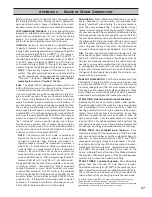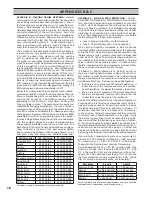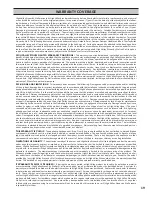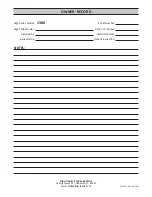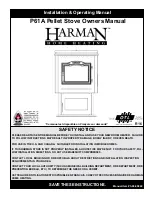
15
O
G
S
H
:
Always operate the wood heater
according to the guidelines on page 12, especially in re-
gard to opening the Air Damper before opening the Load-
ing Door and opening the door gradually. A modern wood
heater, properly installed and connected to a good chim-
ney which provides adequate dra , should not leak smoke
into the home. Air will be drawn into the wood heater, and
into any small gaps in the connector pipe, by the nega ve
pressure created within the wood heater and chimney by
"dra ." If smoke is leaking into the home from the wood
heater or the connector pipe there is inadequate dra or
the chimney is blocked in some way. A smoke alarm or
CO detector sounding will signal smoke leakage, and they
should be installed throughout your home. But even be-
fore a smoke detector is ac vated, a whi
ff
of smoke should
alert you to the fact that there is a ven ng problem. By-
products of wood heater combus on do contain carbon
dioxide, carbon monoxide, water vapor, tars, etc., but the
dis nc ve aroma of wood smoke also accompanies them.
Nega ve pressure in the home can also contribute to
smoke leakage. Today's homes are constructed to be
much ghter and be er insulated than older homes.
Older homes tended to "breathe" as fresh air was drawn
in through myriad cracks to replace the air that rose up
the chimney. Today well designed homes are equipped
with "replacement air" systems to bring fresh air into the
home. Without replacement air, ght homes can inhibit
chimney dra and may cause the
fl
ow of the chimney to
reverse when a vented appliance, such as a kitchen hood,
is turned on. Tight homes and house pressures are com-
plicated subjects, but they can be analyzed and corrected.
If there is smoke leakage, or the
fi
re in the wood heater
slows or "stalls" under these condi ons, consult your deal-
er. Outside air can be brought directly to the wood heater
to help relieve nega ve house pressure condi ons.
C
F
R
:
When wood is
burned slowly, it produces tar and other organic vapors
which combine with moisture to form creosote. Modern
wood heaters, properly sized and operated, should not
produce smoke or creosote to the degree that older stoves
did, but the same elements are present. At one me it
was popular to install a very large wood stove, load it full
of wood, and reduce the combus on air; perfect condi-
ons for producing creosote. Tars and vapors, combined
with moisture, condense in the chimney at temperatures
below @ 250°F. The resul ng creosote can accumulate
and cling ghtly to the
fl
ue liner and, if ignited, can create
a very hot and frightening chimney
fi
re.
Creosote producing tars and vapors are burned at tem-
peratures over 1100°F inside a modern wood heater evi-
denced by the
fl
ames at the top of the
fi
rebox during the
second stage of combus on. Ensure that there is always
enough combus on air to support secondary combus on.
Even s ll, a rela vely cool chimney, especially an exterior
masonry chimney, can cool the exhaust gasses before they
exit the
fl
ue and some creosote will be produced. The
chimney connector and chimney should be inspected at
least once every two months during the hea ng season
to determine if creosote build-up has occurred. Contact
your High Valley dealer or local chimney sweep if you are
uncertain how to inspect the system for any build-up.
I C
C
F
:
If your wood heater is op-
erated properly to maintain clean, e
ffi
cient combus on,
connected to a good chimney, burning good, dry wood,
and inspected as needed, a chimney
fi
re should be an un-
likely occurrence. A chimney
fi
re can create a loud rushing
sound and, perhaps, banging noises within the chimney.
Should a chimney
fi
re occur despite your best e
ff
orts, alert
everyone in the home and leave the building immediately.
Contact the
fi
re department. If it appears safe to enter
the home, close the Air Damper and manual damper (if so
equipped) wearing a heat resistant glove, to cut o
ff
air to
the
fi
re. Do not throw water on the wood heater. Thermal
shock could break the door glass or otherwise damage the
wood heater. Have the chimney inspected and cleaned or
repaired as necessary before resuming opera on of the
wood heater. Always have the chimney cleaned at the end
of the burning season or before the following fall.
A
D
:
Remove ashes once they get @ 2" to 3"
deep, or deep enough to impede the primary air inlet be-
neath the Loading Door opening. Remove ashes when the
fi
re is rela vely cool at the end of the charcoal stage of
combus on. Use a steel rake to gather unburned charcoal
or embers to one side and leave them in the
fi
rebox to be
consumed as fuel. Remove spent ash only, leaving @ ½"
to 1" of ash remaining in the
fi
rebox to insulate the ember
bed. Use a steel shovel to carefully remove the spent ash-
es into a steel container with a ght-
fi
ng lid and move
the container outdoors immediately. Take care to avoid
shoveling up burning embers with the spent ash. Embers
can stay hot in the bed of ashes for days insulated in the
ash. The closed container of ashes should be placed on
a non-combus ble surface or on bare ground, well away
from any building and all combus ble materials, pending
fi
nal disposal. If the ashes are to be disposed of by burial
in soil or otherwise locally dispersed, they should be re-
tained in the closed container un l all embers have thor-
oughly cooled. No other waste of any kind shall be placed
in this container.
Some ashes may spill while removing them from the
fi
re-
box. Ashes can be vacuumed up once they are proved to
be completely cool, but be advised that
fi
ne ash can pass
through the vacuum and into the home. Special vacuums,
designed for ash clean-up and removal and equipped with
heat resistant
fi
lters, are available through your dealer.
C
G
:
Your wood heater is equipped with a
clear window to permit a view of the
fi
re. The material is
generically referred to as "stove glass", but it is not glass
in the conven onal sense. The ceramic material is made
to withstand the very high temperatures that a modern
wood heater can a ain and has excellent heat resistance
and strength characteris cs. However the ceramic can
be damaged through improper use. Inspect the ceramic
regularly for signs of damage. Never operate the wood
heater with cracked, damaged, or broken ceramic glass.
Allow the ceramic to cool completely before cleaning
.
Never use abrasive cleaners which may cause scratches
which can develop into cracks. Use a mild window cleaner
or special stove glass cleaners available from your dealer.
Heavy deposits may be removable with a damp cloth or
damp newsprint dipped in wood ash.

















